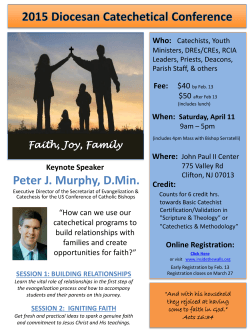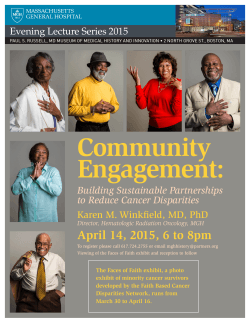
PDF - Virtual Mentor American Medical Association Journal of Ethics
American Medical Association Journal of Ethics May 2015, Volume 17, Number 5: 409-415 FROM AN AMA JOURNAL OF ETHICS SPECIAL CONTRIBUTOR Incorporating Spirituality into Patient Care Robert D. Orr, MD, CM Religion and Medicine The histories of medicine and religion have been interwoven for centuries. Many faithbased communities, organizations, and agencies established hospitals and hospices as part of their ministry. In the modern era, however, the two became increasingly separated as medicine became more scientific, developing what became known as the biomedical model in the mid-nineteenth century. During this period of secularization of medicine, some religious hospitals remained true to their faith-based mission, while many retained their religious identity in name only. In 1977, George Engel, a professor of psychiatry, wrote a classic article in which he urged medical educators, researchers, and practitioners to abandon the reductionist biomedical model of disease and adopt a broader perspective that could incorporate “the social, psychological and behavioral dimensions of illness” [1]. He called his proposal the biopsychosocial model. This new model was adopted rather widely in Western medicine over the next generation. In spite of this broader biopsychosocial perspective, or perhaps because of it, the boundary separating the practice of contemporary Western medicine from religion became more sharply delineated. When a patient or even a clinician raises a tenet of religious faith while discussing health care, one often hears the retort, “Medicine is secular; religion is sacred and private.” This answer implies that medicine in its three dimensions (biological, psychological, and social) specifically excludes the spiritual dimension that belongs to a sacred space that a patient need not talk about and that need not be considered in the clinician’s concept of caring for individuals. This distinction is exemplified by the fact that, although nearly all hospitals offer chaplaincy services, in most settings the chaplain is not viewed as part of the clinical team but as an ancillary consultant. In one sense, however, this recognition that religion is separate and distinct has again broadened the concept of whole-person medicine so that it now encompasses four overlapping domains: biological, psychological, social, and spiritual. A few US medical schools established in the last 175 years expanded the biomedical model, adding the concept of caring for the whole person by including in their mission statements the importance of a spiritual dimension in patient care [2, 3]. This development suggests AMA Journal of Ethics, May 2015 409 that health care professionals should have a better understanding of the patient’s personal, cultural, and religious values. Religion and Medical Ethics As medical technology began to expand rapidly in the 1960s and ’70s, offering means of extending the lives of mortally ill people, some began to ask “should we…?” questions in addition to “can we…?” questions. These are value-based questions, not clinical or even scientific questions. Just because we can do something doesn’t mean that we should do it. Such questions arise very commonly today in situations involving end-of-life care, limitation of treatment, treatment of patients who have what is perceived by others to be diminished quality of life, use of limited or expensive resources, and so on. These questions are often discussed in bedside situations that are referred for consultation with a clinical ethics consultant or committee. The idea that medicine is inherently a moral enterprise—that the practice of medicine involves making decisions between right and wrong, good and bad—entered our conversation at this time of technological expansion [4]. When questions of right and wrong in medicine were first voiced, it was often by people of faith who recognized that religious traditions addressed these values. Indeed, the early medical ethicists were primarily theologians coming from Roman Catholic, Protestant, and Jewish traditions [5]. Although the discipline has largely been taken over by philosophers, clinicians, the courts, and health policymakers, the roots of medical ethics are clearly faith based. How does the moral dimension of medicine comport with the above-mentioned boundary between medicine and faith? Quite easily, actually. Those involved in medical decisions are people: patients, families, professionals. All of these people have values, often based on faith. Foundations of Medical Ethics: Secular and Sacred Principles Although there are several conceptualizations of medical ethics [6], probably the most commonly articulated in North America is principlism. While insufficient of and by itself to thoroughly resolve all dilemmas in medical ethics, principlism is often the beginning point for such discussions. The secular principles of medical ethics are well known and have been discussed at length in many settings [7]. The four foundational principles are (1) nonmaleficence (first of all, do no harm), (2) beneficence (always seek the patient’s best interest), (3) respect for autonomy (the patient has a right to self-determination), and (4) justice (we should treat like patients alike, without discrimination). In modern Western culture, respect for autonomy has become the “first” principle “among equals.” A person has the right to make his or her own decisions about medical treatment. This principle is often expressed as respect for persons. And, of course, patients are persons, complete with values, some of which are faith based. 410 www.amajournalofethics.org The theologians who pioneered contemporary medical ethics also built their foundation on principles, but these were sacred. These sacred principles often parallel or overlap the four secular principles. Elsewhere I have tried to identify some of the sacred precepts and beliefs held by members of one or more of the three monotheistic faith traditions (Judaism, Christianity, Islam) that may be influential, sometimes even determinative, in resolving dilemmas in medical ethics [8]. I will outline 11 of them from my own Christian perspective, recognizing that there is much overlap with Jewish and Islamic perspectives. The Imago Dei (the image of God in man). From the first chapter of Genesis, the first book of the Hebrew Bible, we learn that each individual, regardless of ability or disability, bears the image of God. This is inherent, not imputed, and may be difficult to understand as we contemplate persons born with anencephaly or afflicted with severe dementia. Although such disabilities are part of the mortal nature of humankind, they do not detract from the underlying principle. The sanctity of life. Because we bear the image of God, each human life is sacred. Human life is special; it is different from animal life. Our God-given dominion (see below) allows us sometimes to end an animal’s life humanely, but it does not allow us intentionally to end a human life. This belief in the sanctity of life does not mean, however, that we must always attempt to postpone human death, another inevitable consequence of the Fall. The Fall, suffering, disease, and death. Because of Adam’s sin, we live in a fallen world with all its manifestations. We should try to relieve suffering. We should try to cure or control disease. We should try to avoid death when possible. But, in the end, we are all finite. Quality of life. Some people of faith bristle when quality of life is mentioned, arguing that we should only focus on the sanctity of life. But we all experience a quality of life—good, bad, or neutral. And when the burdens of continued life make it impossible for us to carry out God’s purpose, we are not obligated to use disproportionate measures to forestall death. Miracles. Adherents of all three monotheistic faith traditions believe, based on their own sacred texts, that God is capable of intervening in our lives in ways that we cannot explain or understand, in ways that seem to contradict the laws of nature. Unfortunately, we tend to use the word “miracle” too loosely, as in “miracle drugs,” “miraculous survival,” and so on. True supernatural interventions are not common in my experience. But God can do such things when He chooses. In addition, He does not need our machines or procedures to accomplish His miracles. Compassion. God’s incomprehensible love for us is clearly reflected in the compassion taught and demonstrated by Jesus. It is incumbent on us to remember that compassion AMA Journal of Ethics, May 2015 411 means “to suffer with.” Some misinterpret the word to mean merciful ending of a patient’s life. Instead, in my view, we are called to do our utmost for patients’ suffering: to suffer along with them and not abandon them. The ministry of health care. Many religious health care professionals believe that the work we do is a ministry to those in need, a way to show forth God’s love. The hope of eternity. Many people of faith believe that this life, with its suffering and death, is not all there is. We have the hope of eternal life with a loving God. Some people of faith believe that we should always hope for a good outcome to illness. Václav Havel, former president of the Czech Republic, insightfully wrote that hope “is not the conviction that something will turn out well, but the certainty that something makes sense, regardless of how it turns out” [9]. The sovereignty of God. As human beings, we live in a fallen world, beneath the sovereignty of an all-powerful God. Dominion and stewardship. God has granted us liberty, expecting us to make decisions about the use of our abilities and resources. In contemporary medicine, the timing of death is often a matter of choice. The time of death for a patient may vary considerably based on whether we choose to use cardiopulmonary resuscitation, ventilator support, dialysis, one more round of chemotherapy, antibiotics, or a feeding tube. Free will. Many people of faith equate the religious concept of free will and the secular concept of autonomy. In one sense, they are similar: both refer to making our own decisions. However, in a clearer sense, the Hebrew prophet Micah placed a limit on our free will when he wrote, “He has showed you, O Man, what is good. And what does the Lord require of you? To act justly and to love mercy and to walk humbly with your God” [10]. We are not to walk arrogantly as free moral agents, making decisions based only on our personal values, desires, and authority. Rather, we are to acknowledge humbly our position under God’s authority. Justice. Our imperfect efforts at individual and social justice must constantly strive to reflect God’s perfect justice. However, justice involves getting what we deserve. In a Christian context, we should also strive to reflect His mercy (not getting what we deserve), and His grace (getting what we do not deserve). Some faith-based precepts are absolute, or nearly so, such as the Roman Catholic proscription against intentionally causing death, the Orthodox Jewish prohibition against stopping life-sustaining treatment, and the Jehovah’s Witnesses’ refusal of many blood products. Some are interpreted with a great deal of flexibility, such as an understanding of quality of life. Some are equally shared with nonreligious persons, such as compassion 412 www.amajournalofethics.org and justice. As patients and families struggle with some of the difficult issues and questions encountered in medicine, they may or may not recognize that they are dealing with tenets of their own faith. Inquiring about their faith, identifying these precepts, and discussing them openly, sometimes with the aid of a chaplain or their own clergy, will often help bring clarity and resolution. The Professional’s Right of Conscience Sensitivity to the role of personal and religious values in understanding and resolving dilemmas in clinical ethics focuses primarily on the beliefs of patients and families. However, the professionals involved in these dilemmas are also persons and, as such, have their own personal and religious values. Involvement in counseling about, or especially performing, procedures such as abortion, sterilization, withdrawal of lifesupporting treatments, physician-assisted suicide, and so on might violate the precepts of a health care professional’s religious values. The professional’s right of conscience has been the subject of a growing literature in medicine and ethics [11]. It is often important to recall the moral difference between a patient’s negative autonomy (the right to refuse; the right to be left alone) and positive autonomy (entitlement to have one’s wishes carried out by others). The Patient’s Personal Values The values used by individuals in making difficult medical decisions can be very personal. Some personal values are based primarily on one’s religious beliefs. Some are based more broadly on a person’s worldview or philosophy of life. Health care professionals should be careful not to assume a patient holds specific values based only on the designation in the medical record of their “religious preference” or an identification of their cultural background. Different congregations in a particular faith tradition may interpret such values differently, and clearly different individuals within a tradition may adhere to all, some, or very few of the precepts of that faith. Similar diversity of thought is seen within many groups. So how does a clinician inquire of patients to learn what values are important to them? There have been many proposals of how to discuss the spiritual element by taking a spiritual history [12]. One of the most commonly used and user-friendly is the model developed by Pulchalski and Romer [13], who propose the following four questions organized by the mnemonic “FICA”: F—Do you belong to a faith tradition? I—How important is your faith to you? C—Do you belong to a faith community? A—How does your faith affect how you would like me to care for you? AMA Journal of Ethics, May 2015 413 Since only a portion of personal values are based on a person’s faith, I would suggest supplementing this spiritual history with a fifth question: “What personal values do you have that might also affect how you would like me to care for you?” This information can easily be elicited while taking a patient’s medical history without being intrusive. This approach recognizes that the patient’s faith may be an important part of his or her self and that the care team is willing, even eager, to incorporate personal and religious beliefs into needed decisions about treatment. In addition, it may be appropriate to ask patients or families if they would like to talk with the hospital chaplain or their own pastor, priest, rabbi, or spiritual advisor. Conclusion There is an increasing recognition in modern Western medicine of the importance of patient spirituality in treatment and healing. Nowhere is this more important than in addressing and resolving dilemmas in bedside medical ethics. It is thus important for clinicians to know how to take, and to be comfortable with taking, a patient’s spiritual history in a nonintrusive way. Health care professionals must likewise recognize when their own values raise dilemmas in their practice of medicine and must be able to deal with issues that may arise from their own right of conscience. References 1. Engel GL. The need for a new model: a challenge for biomedicine. Science. 1977;196(4286):130. 2. Georgetown University School of Medicine. Mission and diversity statement. https://georgetown.app.box.com/s/j0ozend4kza575gqv35h. Accessed March 16, 2015. 3. Loma Linda University School of Medicine. Our mission. http://www.llu.edu/medicine/about/mission.page. Accessed March 16, 2015. 4. Pellegrino ED. The anatomy of clinical judgments: some notes on right reason and right action. In: Engelhardt HT Jr, Spicker SF, Towers B, eds. Clinical Judgment: A Critical Appraisal. Dordrecht, Holland: D. Reidel Publishing Company; 1979:169194. 5. Verhey A, Lammers SE, eds. Theological Voices in Medical Ethics. Grand Rapids, MI: William B. Eerdmans Publishing Company; 1993. 6. For example, casuistry, consequentialism, deontology, narrative ethics, and virtue ethics. 7. Beauchamp TL, Childress JF. Principles of Biomedical Ethics. 6th ed. New York, NY: Oxford University Press; 2008. 8. Orr RD. A theological foundation. In: Medical Ethics and the Faith Factor: A Handbook for Clergy and Health-Care Professionals. Grand Rapids, MI: William B. Eerdmans Publishing Company; 2009:22-33. 414 www.amajournalofethics.org 9. 10. 11. 12. 13. Havel V, Hvizdala K. Disturbing the Peace: A Conversation with Karel Hvížd̕ala. New York, NY: Alfred A. Knopf; 1990:181. Micah 6:8 (RSV). See, for example, the March 2013 issue of AMA Journal of Ethics. Lucchetti G, Bassi RM, Lucchetti AL. Taking spiritual history in clinical practice: a systematic review of instruments. Explore (NY). 2013;9(3):159-170. Puchalski C, Romer AL. Taking a spiritual history allows clinicians to understand patients more fully. J Palliat Med. 2000;3(1):129-137. Robert D. Orr, MD, CM, is a retired clinical ethicist who has taught bioethics at Loma Linda University School of Medicine in California, the Graduate School of Trinity International University in Illinois, the University of Vermont College of Medicine, and the Graduate College of Union University in New York City. He is the author of Medical Ethics and the Faith Factor (Eerdmans, 2009). Related in the AMA Journal of Ethics Doing a Culturally Sensitive Spiritual Assessment: Recognizing Spiritual Themes and Using the HOPE Questions, May 2005 Physicians and Patients’ Spirituality, October 2009 Invoking Shared Beliefs in End-of-Life Decision Making, March 2013 The Limits of Conscientious Refusal: A Duty to Ensure Access, March 2013 Institutional Conscience and Access to Services: Can We Have Both? March 2013 Access and Conscience: Principles of Practical Reconciliation, October 2009 The viewpoints expressed in this article are those of the author(s) and do not necessarily reflect the views and policies of the AMA. Copyright 2015 American Medical Association. All rights reserved. ISSN 2376-6980 AMA Journal of Ethics, May 2015 415
© Copyright 2025









